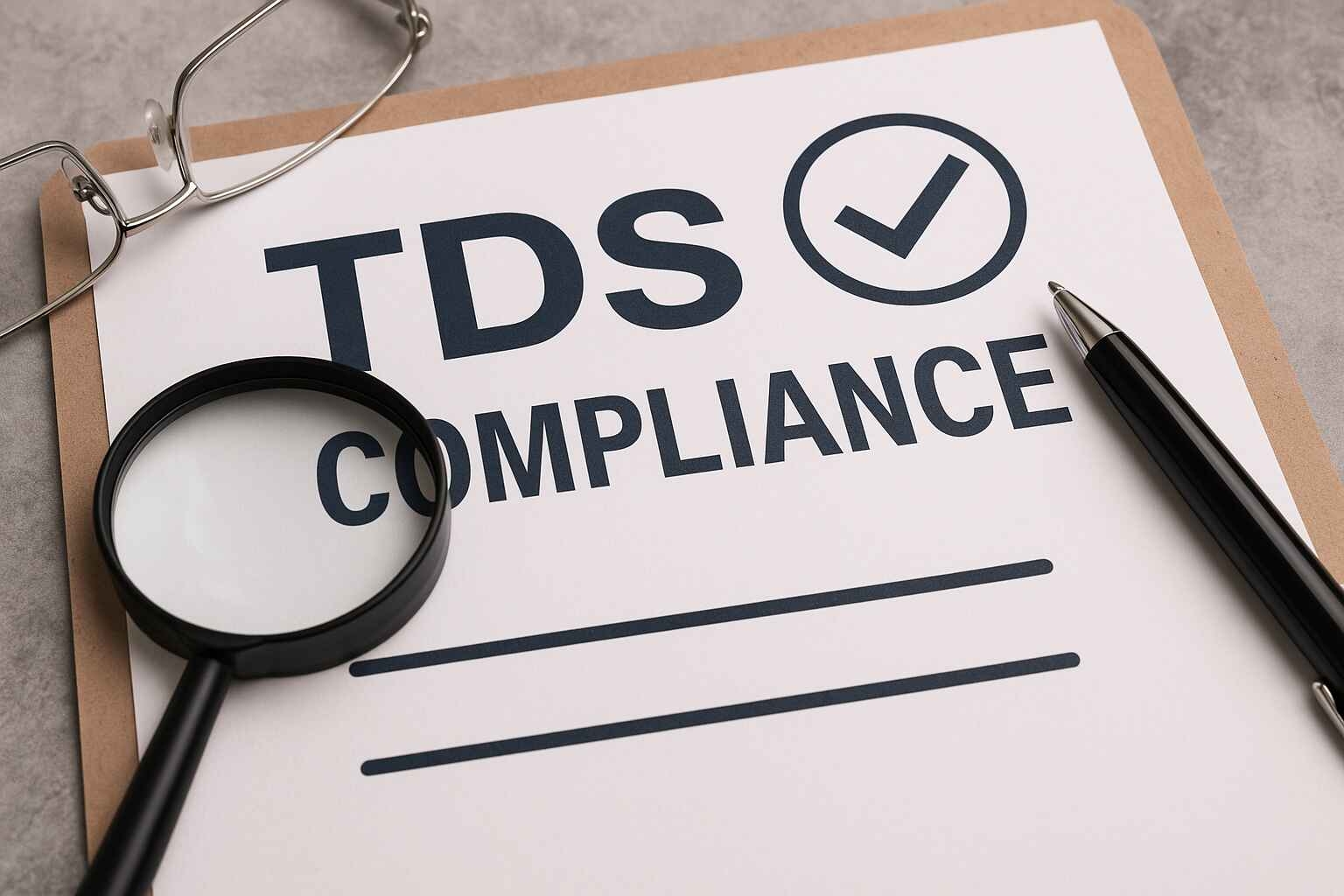TDS compliance is a critical aspect of India’s taxation framework. Tax Deducted at Source (TDS) is a mechanism introduced by the Income Tax Department to collect tax at the very source of income. The main idea behind TDS is to deduct tax from income before it reaches the taxpayer, ensuring a steady inflow of revenue to the government and minimizing tax evasion. Whether you're a salaried employee, business owner, or a freelancer, understanding TDS compliance is essential to avoid penalties, maintain financial transparency, and file accurate returns. This blog provides a detailed overview of TDS compliance, including its rules, filing procedures, due dates, and tips to avoid common mistakes.
Understanding TDS and Its Importance
TDS, or Tax Deducted at Source, is an essential part of India’s tax collection strategy.
-
It is applicable to various income types like salary, interest, rent, commission, and professional fees.
-
TDS ensures regular revenue collection and promotes tax discipline.
-
The deductor (payer) is responsible for deducting TDS and depositing it with the government.
-
TDS compliance reduces the chances of tax evasion by tracking income at the source.
-
It aids in efficient tax administration and faster refund processing.
-
TDS certificates like Form 16 and 16A are crucial for both deductors and deductees.
-
Non-compliance can lead to interest, penalties, and even prosecution.
Who Needs to Deduct TDS
TDS compliance applies to both individuals and organizations depending on certain criteria.
-
Employers deduct TDS on salaries paid to employees as per income tax slabs.
-
Businesses and professionals must deduct TDS on payments exceeding threshold limits.
-
Individuals making large rental payments also need to comply with TDS rules.
-
Financial institutions deduct TDS on interest income earned from fixed deposits.
-
Companies deduct TDS on contractor payments, commissions, and royalties.
-
Freelancers may need to deduct TDS when outsourcing work if turnover limits are met.
-
Deductors must obtain a TAN (Tax Deduction and Collection Account Number).
TDS Rates and Thresholds for Different Payments
TDS rates vary based on the type of income and nature of the payment.
-
Salary TDS is based on income slabs applicable to the employee.
-
10% TDS is levied on interest from bank FDs if it exceeds Rs. 40,000 (Rs. 50,000 for senior citizens).
-
Rent payments above Rs. 2.4 lakh annually attract 10% TDS.
-
1% TDS is applicable on property purchases above Rs. 50 lakh.
-
2% TDS is deducted on payments to contractors or professionals.
-
TDS on commission and brokerage is 5% if it exceeds Rs. 15,000 annually.
-
Lower or nil deduction can be applied through Form 15G/15H or certificate under Section 197.
TDS Deduction and Deposit Process
Deducting and depositing TDS timely is central to TDS compliance.
-
TDS must be deducted at the time of credit or payment, whichever is earlier.
-
The deducted amount must be deposited with the government within the 7th of the next month.
-
Use challan ITNS 281 to deposit TDS online via the NSDL portal.
-
TAN number and correct section code must be used while depositing TDS.
-
Late deposits attract interest at 1.5% per month.
-
Quarterly TDS returns must be filed in addition to deposits.
-
Proper accounting and documentation ensure smoother audits and assessments.
Filing TDS Returns and Due Dates
Filing quarterly returns is a mandatory part of TDS compliance.
-
Returns must be filed quarterly using Form 24Q (salaries), 26Q (non-salaries), and 27Q (foreign payments).
-
Due dates are 31st July, 31st October, 31st January, and 31st May for Q1 to Q4 respectively.
-
Returns must include PAN of deductees, amount paid, TDS deducted, and deposited.
-
Use TDS return filing software or government utilities to file accurately.
-
TDS returns must be verified using a digital signature or electronic verification code (EVC).
-
Filing errors can lead to notices, penalties, and mismatches in Form 26AS.
-
Accurate filing reflects good financial governance.
TDS Certificates and Form 16/Form 16A
TDS compliance includes issuing certificates to deductees.
-
Form 16 is issued for salary TDS and includes income and deduction details.
-
Form 16A applies to TDS on non-salary income like interest or rent.
-
These certificates must be issued quarterly or annually depending on the form type.
-
They help deductees file their income tax returns accurately.
-
Employers must issue Form 16 by 15th June of the following financial year.
-
Digital signature on these forms is mandatory.
-
Certificates act as proof of tax deducted and deposited.
Consequences of Non-Compliance with TDS Rules
Failing to meet TDS compliance norms can lead to serious penalties.
-
Interest of 1% to 1.5% per month is levied for late deduction or deposit.
-
A penalty of Rs. 200 per day is charged for delayed return filing.
-
Non-filing of returns may attract penalties up to Rs. 1 lakh.
-
Disallowance of expenses under Section 40(a)(ia) in tax assessments.
-
Prosecution is possible in extreme cases of willful default.
-
Regular defaults can harm creditworthiness and vendor relationships.
-
Staying updated and compliant helps avoid unnecessary legal troubles.
How to Correct TDS Filing Errors
Even small errors in TDS filing can disrupt compliance, but they can be rectified.
-
File a correction return using RPU (Return Preparation Utility).
-
Common errors include wrong PAN, incorrect section code, or mismatch in challan details.
-
Use the TRACES portal to download consolidated TDS files.
-
Validate data with FVU (File Validation Utility) before submission.
-
Keep communication records and justification for corrections made.
-
Updated returns help avoid scrutiny and notices.
-
Timely correction maintains smooth TDS compliance.
Using Technology for Better TDS Compliance
Tech tools can simplify and enhance TDS compliance for businesses and professionals.
-
Use payroll and accounting software to auto-calculate TDS.
-
Online TDS return filing portals ensure error-free submissions.
-
Set up calendar reminders for TDS deposit and return due dates.
-
Generate TDS certificates and Form 16 digitally.
-
Cloud-based systems allow real-time tracking and compliance status.
-
Integrate PAN verification tools to avoid errors.
-
Automation reduces manual errors and saves time.
Best Practices for Maintaining TDS Compliance
Adopting disciplined practices ensures seamless TDS management.
-
Deduct and deposit TDS timely without waiting for due dates.
-
Maintain accurate and updated employee/vendor records.
-
Reconcile TDS data with Form 26AS and AIS regularly.
-
Issue TDS certificates promptly to avoid follow-ups.
-
Educate accounting staff about TDS rules and updates.
-
Perform periodic audits of TDS transactions.
-
Consult a tax professional for complex TDS scenarios.
Conclusion
TDS compliance isn’t just a regulatory requirement—it’s a critical element of maintaining financial transparency and organizational discipline. Whether you're managing a business or working as a salaried individual, understanding the ins and outs of TDS helps prevent legal hassles, avoid penalties, and maintain smooth cash flows. From timely deduction and deposits to accurate filings and certificate issuance, every step in the TDS journey demands attention to detail. Embracing digital tools and professional advice can further streamline compliance. Stay informed, stay compliant, and turn TDS from a burden into a manageable routine that strengthens your financial foundation.







